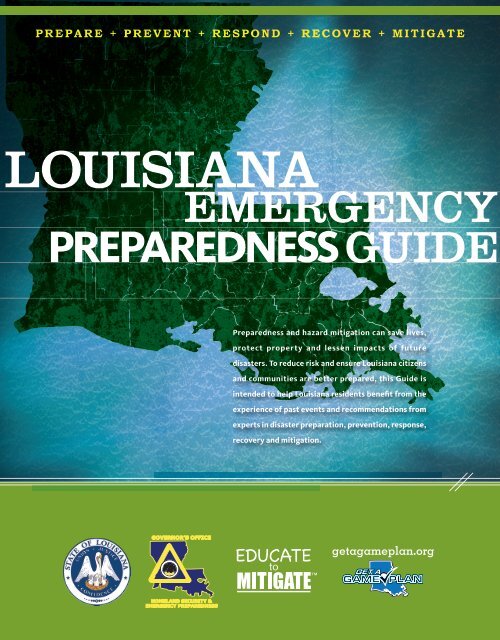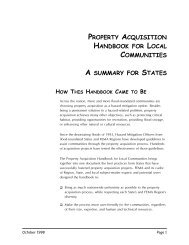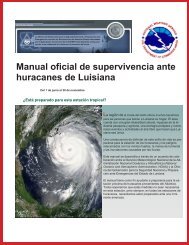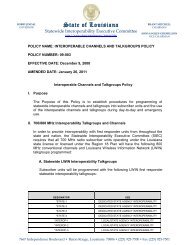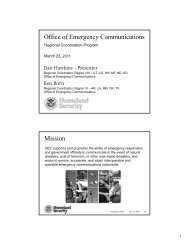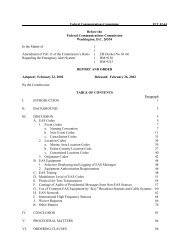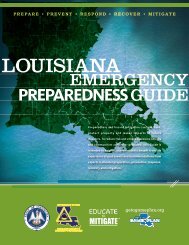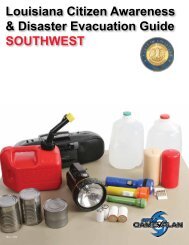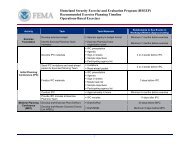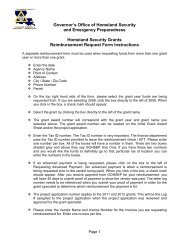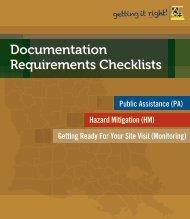Download - Governor's Office of Homeland Security & Emergency ...
Download - Governor's Office of Homeland Security & Emergency ...
Download - Governor's Office of Homeland Security & Emergency ...
Create successful ePaper yourself
Turn your PDF publications into a flip-book with our unique Google optimized e-Paper software.
PREPARE + PREVENT + RESPOND + RECOVER + MITIGATE<br />
LOUISIANA<br />
EMERGENCY<br />
PREPAREDNESS GUIDE<br />
Preparedness and hazard mitigation can save lives,<br />
protect property and lessen impacts <strong>of</strong> future<br />
disasters. To reduce risk and ensure Louisiana citizens<br />
and communities are better prepared, this Guide is<br />
intended to help Louisiana residents benefit from the<br />
experience <strong>of</strong> past events and recommendations from<br />
experts in disaster preparation, prevention, response,<br />
recovery and mitigation.
[ 1 ]<br />
LOUISIANA EMERGENCY<br />
PREPAREDNESSGUIDE<br />
Table<br />
<strong>of</strong><br />
Contents<br />
Important Terms You Should Know 2<br />
State Hazards 3<br />
THE IMPACTS OF NATURAL DISASTERS<br />
ARE FELT ACROSS AMERICA<br />
The impacts <strong>of</strong> disaster incidents, whether natural or manmade,<br />
are felt across Louisiana as a result <strong>of</strong> the multiple<br />
hazards and risks we are most likely to face. In Louisiana, we<br />
have developed plans to prepare, prevent, respond, recover<br />
and mitigate the impacts <strong>of</strong> future incidents.<br />
The Louisiana <strong>Emergency</strong> Preparedness Guide (Guide) provides<br />
an overview <strong>of</strong> what you can do to better prepare yourself,<br />
your family, your pets and your business. I encourage you to<br />
study the Guide and Get A Game Plan for your family. I also<br />
encourage you to listen carefully to the direction <strong>of</strong> local<br />
<strong>of</strong>ficials and prepare to evacuate if that becomes necessary.<br />
For more information, please visit the Get A Game Plan<br />
website at getagameplan.org.<br />
Sincerely,<br />
Bobby Jindal, Governor<br />
PREPARE<br />
High Wind + Tornado 4<br />
Flooding + Ice 4<br />
<strong>Emergency</strong> Supply Checklist 5<br />
Family Preparation 7<br />
Pets 8<br />
Get A Game Plan + Apps + Links 9<br />
Business Preparation 11<br />
PREVENT<br />
Reporting Suspicious or<br />
Criminal Activity 12<br />
Hurricane Tracking Chart 13<br />
RESPOND<br />
State Evacuation Map 15<br />
Parish Resources 16<br />
Contraflow 17<br />
Evacuation/Sheltering/<br />
Staying Home 19<br />
<strong>Emergency</strong> Shelter<br />
Information Points 20<br />
Special Needs 20<br />
Louisiana <strong>Emergency</strong> Information 21<br />
After the Storm – Returning 22<br />
RECOVER<br />
Recovery Assistance 23<br />
HAZARD MITIGATION<br />
Hazard Mitigation 25<br />
My Personal Plan 26
[ 2 ]<br />
PREPARE + PREVENT + RESPOND + RECOVER + MITIGATE<br />
Important Terms<br />
You Should Know<br />
PARISH EMERGENCY OPERATIONS CENTER (EOC):<br />
The facility that provides coordination and control <strong>of</strong> all<br />
emergency response and recovery activities for the Parish<br />
during declared emergencies.<br />
EMERGENCY ALERT SYSTEM (EAS): A state-<strong>of</strong>-the-art<br />
digital system designed to give emergency information and<br />
instructions from Federal, State and local authorities. The<br />
system is interfaced with the cable television system as well<br />
as radio and television stations. When activated, it broadcasts<br />
the latest information on weather reports, road conditions,<br />
evacuations, shelter locations and reentry information.<br />
EVACUATION ORDER: The most important instruction<br />
you will receive from local government <strong>of</strong>ficials. When<br />
appropriate, the State <strong>of</strong> Louisiana Evacuation Plan goes<br />
into effect. This plan may require, depending on predicted<br />
impact, the evacuation <strong>of</strong> everyone in south Louisiana in<br />
vulnerable areas.<br />
EYE: The low-pressure center <strong>of</strong> a tropical cyclone or<br />
hurricane. Though the most intense area <strong>of</strong> the storm<br />
surrounds it, winds are normally calm and sometimes the<br />
sky clears.<br />
EYE WALL: The ring <strong>of</strong> thunderstorms that surrounds a<br />
storm’s eye. The heaviest rain, strongest winds and worst<br />
turbulence are normally in the eye wall.<br />
FLASH FLOOD: A flood that occurs within a few hours<br />
(usually less than six [6]) <strong>of</strong> heavy or excessive rainfall or<br />
dam or levee failure.<br />
STORM SURGE: A rise <strong>of</strong> the sea level along the shore that<br />
builds up as a storm (usually a hurricane) moves over water.<br />
It is a result <strong>of</strong> the winds <strong>of</strong> the storm and low atmospheric<br />
pressures.<br />
STORM TRACK: The path that a low-pressure area follows.<br />
TORNADO: A violently rotating column <strong>of</strong> air classified into<br />
three (3) main groups; weak – wind speeds up to 110 mph;<br />
strong – wind speeds 110 to 205 mph; and violent – wind<br />
speeds 205 to perhaps 320 mph.<br />
TROPICAL OR SUBTROPICAL DEPRESSION: Cyclones<br />
that have maximum sustained winds <strong>of</strong> 38 mph (33 knots) or<br />
less. These are referred to as low-pressure systems in public<br />
advisories and statements.<br />
TROPICAL STORM: Tropical cyclone that has maximum<br />
sustained winds from 39 to 73 mph (34 to 63 knots).<br />
WARNING: Issued when a particular weather or flood<br />
hazard is “imminent” or already occurring (e.g., tornado<br />
warning or flash flood warning). A warning is used for<br />
conditions posing a threat to life or property.<br />
WATCH: Forecast issued in advance to alert the public<br />
<strong>of</strong> the possibility <strong>of</strong> a particular weather-related hazard<br />
(tornado watch, flash flood watch). It is intended to provide<br />
enough lead time so those who need to set their plans in<br />
motion can do so.<br />
GALE: Sustained wind speeds from 39 to 54 miles per hour<br />
(mph) (34 to 47 knots).<br />
HURRICANE: A severe tropical cyclone with sustained<br />
winds over 74 mph (64 knots).<br />
KNOT(s): Unit <strong>of</strong> speed used in aviation and marine<br />
activities. One (1) knot is equal to 1.15 mph.
[ 3 ]<br />
PREPARE + PREVENT + RESPOND + RECOVER + MITIGATE<br />
State<br />
Hazards<br />
STATE HAZARD MITIGATION PLAN<br />
The State Hazard Mitigation Plan (SHMP) identifies<br />
hazards and guides the implementation <strong>of</strong> hazard<br />
mitigation measures intended to eliminate or<br />
reduce the effects <strong>of</strong> future disasters that might<br />
impact Louisiana. The plan is reviewed annually.<br />
For more information, visit getagameplan.org/<br />
planMitigate.htm.<br />
11 MOST LIKELY HAZARDS IN LOUISIANA<br />
FLOODING<br />
A natural condition that is the result <strong>of</strong> an<br />
overflowing river, heavy rain, dam break, levee failure<br />
or snow or ice melting too fast. Hurricanes and<br />
tornadoes can also cause flooding.<br />
HAILSTORM<br />
Severe thunderstorms in which chunks <strong>of</strong> ice fall<br />
along with rain.<br />
HURRICANE<br />
A tropical storm with sustained winds at least 74<br />
mph on the Saffir-Simpson Scale. Heavy rain,<br />
strong winds and large waves can damage cars,<br />
buildings and homes. Hurricane season runs from<br />
June 1 – November 30.<br />
TORNADO<br />
A violent storm that appears as a funnel-shaped cone<br />
with winds that can be as strong as 300 mph or more.<br />
Tornadoes can also occur within other storms, such<br />
as hurricanes.<br />
STORM SURGE<br />
Storm surge is an abnormal rise <strong>of</strong> water generated by<br />
a storm, over and above the predicted astronomical<br />
tides. Storm surge should not be confused with<br />
storm tide, which is defined as the water level rise<br />
due to the combination <strong>of</strong> storm surge and the<br />
astronomical tide.<br />
SUBSIDENCE<br />
Subsidence is the loss <strong>of</strong> surface elevation due to the<br />
removal <strong>of</strong> subsurface support. Along with sea level<br />
rise, subsidence can accelerate coastal erosion and<br />
wetland loss, as well as increase flooding.<br />
WILDFIRE<br />
An uncontrolled fire that spreads through vegetation<br />
and possibly exposes and consumes structures.<br />
Wildfires can be caused by human acts such as<br />
arson or careless accidents, as well as by natural<br />
occurrences such as lightning.<br />
DAM FAILURE<br />
Dam failure can occur when there is a breach or<br />
collapse in the structure <strong>of</strong> a dam.<br />
LEVEE FAILURE<br />
A levee failure involves the overtopping, breaching or<br />
collapsing <strong>of</strong> a levee.<br />
HAZARDOUS-MATERIALS INCIDENT<br />
A man-made disaster, hazardous-materials incidents<br />
involve accidental or intentional releases <strong>of</strong> chemical,<br />
biological, radiological or nuclear materials.<br />
ICE STORM<br />
Ice storms consist <strong>of</strong> freezing temperatures and heavy<br />
precipitation, usually in the form <strong>of</strong> rain, freezing rain<br />
or sleet, and sometimes in the form <strong>of</strong> snow and ice.
PREPARE + PREVENT + RESPOND + RECOVER + MITIGATE<br />
[ 4 ]<br />
High Wind<br />
+ Tornado<br />
Tornadoes are nature’s most violent storms. Spawned<br />
from powerful thunderstorms, tornadoes can cause<br />
fatalities and devastate a neighborhood in seconds.<br />
Some <strong>of</strong> the danger signs <strong>of</strong> a tornado are a dark, <strong>of</strong>ten<br />
greenish sky; large hail; a large, dark, low-lying cloud<br />
(particularly if rotating); and loud roaring, similar to a<br />
freight train.<br />
Hurricanes, no matter how weak, are dangerous. The combination <strong>of</strong> storm surge, wind and<br />
other contributing factors determines a hurricane’s destructive power. To compare the disaster<br />
potential <strong>of</strong> sustained wind, emergency forces utilize the Saffir-Simpson scale <strong>of</strong> wind speeds<br />
to help them predict potential hazards. The National Oceanic and Atmospheric<br />
Administration’s (NOAA) forecasters use the Saffir-Simpson Scale.<br />
CATEGORY 1<br />
CATEGORY 2 CATEGORY 3 CATEGORY 4 CATEGORY 5<br />
74 – 95 mph 96 – 110 mph 111 – 130 mph 131 – 155 mph 155+ mph<br />
Hurricane Isaac had Category 1 sustained<br />
winds but extensive damage from flooding<br />
on I-10 in LaPlace.<br />
Graphic courtesy <strong>of</strong> Lafayette Utilities System<br />
Flooding + Ice<br />
PREPARE<br />
Most people in Louisiana associate hurricanes with<br />
devastating winds and storm surge. While strong winds<br />
and high storm surges do cause a tremendous amount <strong>of</strong><br />
coastal destruction, flooding resulting from a hurricane can<br />
occur hundreds <strong>of</strong> miles from the coast. Inland flooding<br />
throughout coastal, central and north Louisiana can<br />
cause severe damage after a hurricane makes landfall and<br />
as the remaining weather system moves through the State.<br />
Since 1970, inland flooding has been responsible for more<br />
than half <strong>of</strong> all deaths associated with tropical storms and<br />
hurricanes in the United States.<br />
Flooding can occur as a result <strong>of</strong> other weather events.<br />
People across the State can be at risk from flooding<br />
caused by heavy rains. People in central and north<br />
Louisiana may be at risk from flooding caused by<br />
melting snow and ice.<br />
Winter storms accompanied by dangerously low<br />
temperatures and sometimes by strong winds, icing,<br />
sleet and freezing rain can also be a danger. Winter<br />
storms can knock out heat, power and communications<br />
services to your home or <strong>of</strong>fice, sometimes for days at a<br />
time. Icy conditions and extreme cold can immobilize an<br />
entire region.<br />
FOR MORE INFORMATION VISIT:<br />
getagameplan.org and ready.gov<br />
Trimming limbs that extend over<br />
buildings in advance <strong>of</strong> ice storms is an<br />
important mitigation measure.
[ 5 ]<br />
PREPARE + PREVENT + RESPOND + RECOVER + MITIGATE<br />
<strong>Emergency</strong> Supply<br />
Checklist<br />
FOOD (3-DAY SUPPLY)<br />
q fruit: canned, dried, roll-ups<br />
q meats: canned or dried<br />
q vegetables: canned<br />
q powdered milk<br />
q juices: canned or bottled<br />
q water: bottled<br />
q peanut butter<br />
q crackers<br />
q soup: canned<br />
q high-energy bars<br />
BABY SUPPLIES<br />
q diapers, baby wipes<br />
q milk, food, formula<br />
q clothes<br />
q disposable bottles and liners<br />
q blankets, sheets, bed liners<br />
q medications<br />
q portable crib<br />
q toys<br />
PERSONAL ITEMS<br />
q soap, toothbrush, deodorant<br />
q towels and washcloths<br />
q sewing kit<br />
q shampoo<br />
q feminine hygiene items<br />
q shaving kit<br />
q mirror<br />
q eyeglasses and contact lenses<br />
q special items needed for the elderly<br />
and disabled<br />
CHILDREN’S SUPPLIES<br />
q quiet toys<br />
q coloring books<br />
q crayons<br />
q puzzles<br />
q books<br />
q CD/MP3 player<br />
q extra batteries<br />
SANITARY ITEMS<br />
q portable toilet<br />
q plastic garbage bags<br />
q paper towels, toilet paper<br />
q liquid detergent<br />
q disinfectant<br />
CLOTHING + BEDDING<br />
q rain gear<br />
q sleeping bags, blankets and pillows<br />
q extra shoes and work boots<br />
q extra clothes<br />
COMMUNICATION EQUIPMENT<br />
q battery-operated radio<br />
q extra batteries<br />
q NOAA weather radio<br />
q cellular phone and charger<br />
q non-cordless phone<br />
LIGHTING<br />
q waterpro<strong>of</strong> flashlights<br />
q battery-powered lantern<br />
q extra batteries<br />
CLEANUP SUPPLIES<br />
q washing detergents<br />
q mops, brooms, etc.<br />
q buckets, extra hose<br />
q old blankets, towels, rags<br />
q large plastic garbage bags and ties<br />
q rubber gloves<br />
q bleach, disinfectants<br />
q camera to photograph home<br />
before cleanup
PREPARE + PREVENT + RESPOND + RECOVER + MITIGATE<br />
[ 6 ]<br />
PAPERS + VALUABLES<br />
q extra set <strong>of</strong> car keys<br />
q evacuation route maps<br />
q driver’s license or some form <strong>of</strong> identification<br />
q Social <strong>Security</strong> cards<br />
q passport<br />
q birth certificates<br />
q vehicle registration papers<br />
q pro<strong>of</strong> <strong>of</strong> residence (deed or lease)<br />
q marriage records<br />
q death records<br />
q computer backups<br />
q small valuables<br />
q extra cash<br />
q credit cards<br />
q wills<br />
q insurance policies<br />
q medical and vaccination records<br />
q other important papers (e.g., stocks, bonds,<br />
mortgages, deeds, wills, recent tax<br />
returns, etc.)<br />
q checking and savings account information<br />
q household inventory (photo or video)<br />
q pet veterinary records<br />
q books, stationery, pens and pencils<br />
SAFETY SUPPLIES<br />
q fire extinguisher<br />
q waterpro<strong>of</strong> matches<br />
q insect repellents<br />
q work gloves<br />
q utility knife<br />
q shovel, hand saw, ax<br />
q hammer, nails, pliers, shut-<strong>of</strong>f wrench<br />
q tarp, duct tape<br />
q small boat<br />
q chain saw<br />
q generator/fuel<br />
q wet/dry vacuum<br />
q extra oil, gas<br />
q jumper cables<br />
q compass<br />
q written instructions on how to turn <strong>of</strong>f<br />
utilities (gas, water, electricity)<br />
PRESCRIPTIONS<br />
q medications (7-day supply)<br />
q list <strong>of</strong> each family member’s prescriptions,<br />
medications, dosage and schedule<br />
q copy <strong>of</strong> health insurance cards and<br />
prescriptions<br />
Don’t forget pet supplies (collar, leash, ID, food,<br />
waste supplies).<br />
EXTERNAL MEDICATIONS<br />
q antibiotic ointment<br />
q antibacterial soap<br />
q baking soda<br />
q hydrogen peroxide<br />
q calamine lotion<br />
q betadine<br />
q lip balm<br />
q rubbing alcohol<br />
q sunblock<br />
INTERNAL MEDICATIONS<br />
q aspirin/acetaminophen<br />
q sore throat lozenges and spray<br />
q laxative/anti-diarrhea<br />
q eyedrops<br />
q antacids<br />
q nose spray<br />
q vitamins<br />
q cough medicine<br />
q eardrops<br />
FIRST AID SUPPLIES<br />
q first aid handbook<br />
q scissors<br />
q tweezers<br />
q thermometer<br />
q first aid tape<br />
q gauze rolls<br />
q large nonstick pads<br />
q bandages, such as Band-Aids<br />
q arm sling<br />
q snakebite kit<br />
q cotton swabs<br />
q ice/heat packs<br />
q latex gloves<br />
q safety pins<br />
COOKING EQUIPMENT<br />
q gas or barbecue grill<br />
q extra propane gas<br />
q lighter fluid/charcoal<br />
q Sterno stove<br />
q cooking utensils<br />
q manual can opener<br />
q bottle opener<br />
q disposable eating utensils<br />
q disposable plates and cups<br />
q paper towels<br />
q ice chest<br />
q plastic storage bags<br />
PREPARE
[ 7 ]<br />
PREPARE + PREVENT + RESPOND + RECOVER + MITIGATE<br />
Family Preparation<br />
PREPARE FOR AN EMERGENCY<br />
• Know what emergencies or disasters are<br />
most likely to occur in your area and have a<br />
emergency kit pre-assembled.<br />
• Inquire about emergency plans at places where<br />
your family spends time: work, daycare and<br />
school, faith organizations, sports events and<br />
commuting.<br />
• Refill prescriptions so that you always have a<br />
seven (7) day supply.<br />
• Identify responsibilities for each member <strong>of</strong><br />
your household and plan to work together as<br />
a team.<br />
• Know the difference between different weather<br />
alerts such as watches and warnings and what<br />
actions to take for each.<br />
• Learn about your community’s warning signals<br />
and frequently monitor television, NOAA radio,<br />
Internet and mobile apps.<br />
>> Don’t wait until the storm approaches to<br />
download your apps.<br />
• If there is a chance you will have to evacuate,<br />
turn the refrigerator and freezer to the coldest<br />
setting and keep them closed as much as<br />
possible so that food will last longer if the power<br />
goes out.<br />
• Listen to local <strong>of</strong>ficials and be ready to evacuate.<br />
Know your evacuation routes and emergency<br />
shelters and checkpoints. Notify someone<br />
outside the disaster area <strong>of</strong> your plans.<br />
• Veterinary and vaccination records for pets and<br />
livestock.<br />
• Photos <strong>of</strong> your home and possessions.<br />
EMERGENCY FUNDS<br />
• Several factors should be considered as to how<br />
disasters will affect your family financially. You<br />
should be prepared to sustain yourself and your<br />
family away from your home for several days or,<br />
in a worst-case scenario, several weeks or even<br />
months. Be advised, government agencies may<br />
not be able to react as quickly as you think they<br />
should.<br />
• Evacuation expenses include fuel, restaurants<br />
and your stay in hotels. When deciding how much<br />
cash to bring for each day, keep those three (3)<br />
items in mind and plan accordingly.<br />
• Average pet boarding costs are different for each<br />
animal depending on size and special needs.<br />
• You should budget enough money to pay for a<br />
month’s supply <strong>of</strong> prescription medicines.<br />
• During a disaster, credit and other bank card use<br />
may be limited due to loss <strong>of</strong> power and other<br />
disaster-related factors. Get more cash than you<br />
think will be necessary.<br />
FOR MORE INFORMATION VISIT:<br />
getagameplan.org/planFamilyStp02.htm and<br />
ready.gov<br />
IMPORTANT PAPERS INVENTORY<br />
Create a personal file containing information about<br />
your possessions and keep it in a secure place, such as<br />
a safe deposit box or waterpro<strong>of</strong> container. Consider<br />
including copies <strong>of</strong> the following for each family<br />
member:<br />
• Driver’s license(s) .<br />
• Vehicle registration and pro<strong>of</strong> <strong>of</strong> insurance.<br />
• Insurance policies (life, health, property).<br />
• Medical and vaccination records including<br />
medicine or food allergies and other specific<br />
health conditions.<br />
• Copies <strong>of</strong> prescription medicine labels.<br />
• Birth and marriage certificates.<br />
• Tax or other important business and personal<br />
records.<br />
• Wills.
PREPARE + PREVENT + RESPOND + RECOVER + MITIGATE<br />
[ 8 ]<br />
Pets<br />
DISASTER PREPAREDNESS FOR PETS<br />
Make sure you have:<br />
• Food and water for at least three (3) days for<br />
each pet.<br />
• Food and water bowls and a manual can opener.<br />
• Depending on the pet, pack litter and litter box<br />
or newspapers, paper towels, plastic trash bags,<br />
grooming items and household bleach.<br />
• Don’t forget pet medications and medical records<br />
stored in a waterpro<strong>of</strong> container, a first aid kit and<br />
a pet first aid book.<br />
• Sturdy leashes, harnesses and carriers to transport<br />
pets safely and to ensure that your pets cannot<br />
escape. A carrier should be large enough for the<br />
animal to stand comfortably, turn around and lie<br />
down. Your pet may have to stay in the carrier<br />
for hours. Be sure to have a secure carrier with<br />
no loose objects. Include blankets or towels for<br />
bedding and warmth and other special items.<br />
• Bring pet toys and the pet’s bed, if you can easily<br />
take it, to reduce stress.<br />
• Current photos and descriptions <strong>of</strong> your pets to<br />
help others identify them in case you and your pets<br />
become separated, and to prove that they are yours.<br />
• Make a copy <strong>of</strong> feeding schedules, medical<br />
conditions, behavior problems and the name and<br />
telephone number <strong>of</strong> your veterinarian in case<br />
you have to board your pets or place them in<br />
foster care.<br />
• The Louisiana Department <strong>of</strong><br />
Agriculture and Forestry and its<br />
non-governmental partners<br />
work year around to support<br />
local response to disasters. Animal<br />
shelters may be available through your<br />
Parish evacuation plan; contact your local <strong>Office</strong> <strong>of</strong><br />
<strong>Homeland</strong> <strong>Security</strong> and <strong>Emergency</strong> Preparedness.<br />
The location <strong>of</strong> your evacuation destination may<br />
or may not accept pets, so call ahead and check.<br />
All hazards disaster preparedness information is<br />
available at ldaf.state.la.us.<br />
• Remember, animal ownership is a responsibility!<br />
Be ready to take care <strong>of</strong> your whole family.<br />
FOR MORE INFORMATION ON DISASTER<br />
PREPAREDNESS FOR YOUR PETS VISIT:<br />
getagameplan.org/planFamilyStp02.htm or the<br />
Louisiana Society for Prevention <strong>of</strong> Cruelty to Animals<br />
(LA SPCA) website LA-SPCA.org or call 504-368-5191<br />
PREPARE
[ 9 ]<br />
PREPARE + PREVENT + RESPOND + RECOVER + MITIGATE<br />
Get a Game Plan<br />
+ Apps + Links<br />
The Governor’s <strong>Office</strong> <strong>of</strong> <strong>Homeland</strong> <strong>Security</strong> and<br />
<strong>Emergency</strong> Preparedness (GOHSEP) hosts an energetic<br />
web-based education and information portal designed to<br />
help Louisiana citizens prepare for, monitor and respond<br />
to disasters.<br />
The website is maintained by GOHSEP and provides<br />
information about hazard mitigation measures, disaster<br />
preparation, ways to respond to an emergency and<br />
how to recover from weather-related disasters, as<br />
well as other hazards. It helps you develop a simple,<br />
yet successful game plan for your family, should an<br />
emergency occur, in order to keep you and your<br />
family safe.<br />
facebook.com/gohsep<br />
youtube.com/user/GOHSEP<br />
twitter.com/gohsep<br />
GETAGAMEPLAN.ORG<br />
The app: <br />
• Identifies places to evacuate and includes pet<br />
sheltering and special needs information.<br />
• Provides critical information and checklists to<br />
help you create a personal evacuation plan. <br />
• Includes evacuation maps for viewing in the<br />
event <strong>of</strong> an emergency or natural disaster with<br />
additional panels for routes and an information<br />
icon to display or email more detailed routing<br />
information. <br />
• Lists important numbers needed in the event <strong>of</strong><br />
an emergency are listed along with the ability<br />
to place a call, text and create a contact for later<br />
retrieval on an iPhone. <br />
FOR MORE INFORMATION VISIT:<br />
getagameplan.org<br />
Visit iTunes to download.<br />
Visit redcross.org/prepare/mobile-apps for descriptions.<br />
Visit iTunes or Google Play to download.<br />
FIRST AID<br />
HURRICANES FINDING TORNADOES WILDFIRE<br />
SHELTERS
PREPARE + PREVENT + RESPOND + RECOVER + MITIGATE<br />
[ 10 ]<br />
ALERT FM<br />
For a description go to alertfm.com/products/mobileapplications<br />
Visit iTunes or Google Play to download.<br />
• Functions like a weather radio, but with unique local<br />
alerts from emergency <strong>of</strong>ficials.<br />
• Offers simple functionality. The user enters a<br />
“home” zip code upon launching the app. This<br />
connects the user with State and local emergency<br />
managers on the network.<br />
FEMA<br />
For a description go to fema.gov/smartphone-app<br />
Visit iTunes, Google Play or Blackberry World to download.<br />
KNOW YOUR PLAN<br />
By Insurance Information Institute<br />
The FEMA app contains disaster safety tips, interactive lists for<br />
storing your emergency kit and emergency meeting location<br />
information, and a map with open shelters and open FEMA<br />
Disaster Recovery Centers (DRCs).<br />
Visit iTunes to download.<br />
Use Know Your Plan – listed as “Your Plan” in iTunes – to be<br />
prepared when disaster strikes! In the event <strong>of</strong> hurricanes,<br />
wildfires, earthquakes, tornadoes, severe cold, evacuations,<br />
this app helps you plan ahead to better protect yourself, your<br />
family, your home and your pets. Get started by using the<br />
preloaded checklists to learn about important mitigation and<br />
preparation steps, or create your own lists from scratch. You<br />
can set due dates, chart your progress, include notes with<br />
your tasks, and share your checklists with family and friends.<br />
Get organized now so you can be ready for what may come.<br />
PREPARE<br />
HEALTHVAULT<br />
Visit HealthVault.com to discover apps that let you:<br />
• Keep all <strong>of</strong> your health records in one place that’s organized<br />
and available to you online.<br />
• Keep track <strong>of</strong> medications, health history, conditions and<br />
illnesses, allergies, x-rays and scans.
[ 11 ] PREPARE + PREVENT + RESPOND + RECOVER + MITIGATE<br />
Business Preparation<br />
PREPARE YOUR BUSINESS FOR A DISASTER<br />
• Document employee roles and responsibilities<br />
during a crisis situation.<br />
• Conduct a drill to make sure your staff<br />
understands their roles and to test your<br />
emergency plan and continuity systems.<br />
• Ask your vendors what their disaster<br />
preparedness plans are so you will know how your<br />
supply chain will be protected.<br />
• Ensure vital records are protected.<br />
>> Review your <strong>of</strong>f-site backup record storage.<br />
>> Place irreplaceable paperwork and digital<br />
storage media in a firepro<strong>of</strong>, waterpro<strong>of</strong> box.<br />
Consider having a “Go Box” with:<br />
• A hard copy <strong>of</strong> your emergency plan.<br />
• A copy <strong>of</strong> a primary, secondary and out-<strong>of</strong>-area<br />
contact information for employees and key<br />
stakeholders.<br />
• A copy <strong>of</strong> insurance policies and agent contact<br />
information.<br />
• A copy <strong>of</strong> contact information for emergency<br />
vendors (contractors, plumbers, electricians, mold<br />
remediation, etc.).<br />
• Laptops and portable backup media for critical<br />
business information.<br />
• Important documents (such as finance records<br />
and an assets inventory).<br />
• General <strong>of</strong>fice supplies and special forms that you<br />
may need to do business at an alternate location.<br />
SECURE THE PREMISES<br />
• Move computers and copiers away from large<br />
windows.<br />
• Cover and elevate inventory.<br />
• Anchor large equipment, cabinets and shelves to<br />
walls or floors.<br />
• Move or store equipment, furniture and valuable<br />
files on the upper level <strong>of</strong> multistory buildings.<br />
>> OR place equipment on concrete blocks<br />
at least 12 inches above projected flood<br />
elevations.<br />
• Cover doors and windows.<br />
THE NATIONAL FLOOD INSURANCE<br />
PROGRAM (NFIP)<br />
fema.gov/national-flood-insurance-program<br />
Almost 40 percent <strong>of</strong> small businesses never reopen<br />
their doors following a disaster because just a few<br />
inches <strong>of</strong> water can cause tens <strong>of</strong> thousands <strong>of</strong> dollars<br />
in damage. Between 2006 and 2010, the average<br />
commercial flood claim amounted to just over $85,000.<br />
Flood insurance is the best way to protect yourself from<br />
devastating financial loss. Find the flood risk for your<br />
business now using our One-Step Flood<br />
Risk Pr<strong>of</strong>ile at floodsmart.gov.<br />
Flood insurance is available to homeowners, renters,<br />
condo owners/renters and commercial owners/renters.<br />
Costs vary depending on how much insurance is<br />
purchased, what it covers and the property’s flood risk.<br />
Coverage for your building and contents is available. Talk<br />
to your agent today about insuring your business and its<br />
contents. Typically, there’s a 30-day waiting period from<br />
date <strong>of</strong> purchase before your policy goes into effect. That<br />
means now is the best time to buy flood insurance.<br />
The Louisiana Business <strong>Emergency</strong> Operations Center<br />
(LA BEOC) supports the coordination <strong>of</strong> activities and<br />
resources <strong>of</strong> businesses and volunteer organizations<br />
with the State’s <strong>Emergency</strong> Operations Center (SEOC)<br />
during emergencies. The LA BEOC provides situational<br />
awareness and identifies critical supply chains <strong>of</strong><br />
goods and services likely to be needed in response to a<br />
disaster or emergency. To find out about the benefits <strong>of</strong><br />
registering with the LA BEOC go to labeoc.org.<br />
Reentering an area may be difficult following a disaster.<br />
Access control is carried out using a tiered approach.<br />
For information go to lsp.org, click on Alerts, then on<br />
<strong>Emergency</strong> Information and then Louisiana Statewide<br />
Credentialing/Access Program. Also be sure to check<br />
with your Parish to see if they have specific reentry<br />
requirements and permits.<br />
FOR MORE INFORMATION ON BUSINESS<br />
PREPAREDNESS AND DISASTER PLANNING VISIT:<br />
getagameplan.org/planBusiness.htm<br />
To download a copy <strong>of</strong> the small-business disaster<br />
preparedness guide From Risk To Resiliency go to<br />
gohsep.la.gov/publications.aspx<br />
<strong>Download</strong> the GET A BUSINESS PLAN<br />
app on iTunes.<br />
ready.gov/planning<br />
fema.gov/protect-your-property-or-businessdisaster<br />
readyrating.org<br />
disastersafety.org/open-for-business
PREPARE + PREVENT + RESPOND + RECOVER + MITIGATE<br />
[ 12 ]<br />
see it.<br />
suspect it.<br />
REPORT IT.<br />
Prevention<br />
HOMELAND SECURITY BEGINS WITH<br />
HOMETOWN SECURITY<br />
If you see something suspicious taking place, report<br />
that behavior or activity to local law enforcement.<br />
Factors such as race, ethnicity, national origin or religious<br />
affiliation alone are not suspicious. For that reason,<br />
the public should report only suspicious behavior and<br />
situations (e.g., an unattended backpack in a public place<br />
or someone trying to break into a restricted area) rather<br />
than beliefs, thoughts, ideas, expressions, associations or<br />
speech unrelated to terrorism or other criminal activity.<br />
Only reports that indicate relevant criminal activity will<br />
be shared with Federal partners.<br />
Fusion Centers manage the flow <strong>of</strong><br />
information and intelligence across<br />
local, State, Tribal and Federal agencies.<br />
In Louisiana, the Fusion Center is<br />
coordinated by State Police (LSP) through<br />
the Department <strong>of</strong> Public Safety (DPS) and<br />
consists <strong>of</strong> a number <strong>of</strong> law enforcement,<br />
public safety and governmental partners. The public plays a<br />
vital role in providing information about potential acts <strong>of</strong><br />
terrorism and terrorist organizations to these centers. Visit<br />
the la-safe.org web site to learn more about the Louisiana<br />
State Analytical and Fusion Exchange (LA-SAFE).<br />
LOUISIANA’S PRIMARY DOMESTIC +<br />
INTERNATIONAL CONCERNS<br />
• Cyber crime<br />
• Drug trafficking organizations<br />
• Gangs<br />
• Immigration smuggling<br />
• Sexual predators<br />
• Suspicious activity<br />
• Transnational + national criminal organizations<br />
• Terrorism<br />
TWO (2) WAYS TO REPORT SUSPICIOUS OR<br />
CRIMINAL ACTIVITY<br />
There are two (2) ways to report suspicious or criminal<br />
activity:<br />
• Contact Louisiana State Police (LSP) Suspicious<br />
Activity Hotline: 1-800-434-8007 or visit lsp.org/<br />
help.html.<br />
• Use the See Send app.<br />
Please remember, in case <strong>of</strong> an emergency, always dial<br />
9-1-1.<br />
SEE SEND APP<br />
The See Something Send Something<br />
app is the preeminent nationwide<br />
suspicious activity reporting (SAR)<br />
tool for citizens to help in the fight<br />
against terrorism. See Something Send<br />
Something has information to educate you on what to<br />
look for and when to submit suspicious activity reports<br />
along with how to receive important alerts. The SAR tool<br />
connects you to a nationwide network <strong>of</strong> Intelligence<br />
Centers by routing tips to the correct center for analysis.<br />
Visit iTunes or Google Play to download the SEE SEND<br />
app. It’s FREE.<br />
PREVENT
[ 13 ]<br />
PREPARE + PREVENT + RESPOND + RECOVER + MITIGATE<br />
95˚<br />
90˚<br />
85˚<br />
80˚<br />
75˚<br />
35˚<br />
Shreveport<br />
Monroe<br />
30˚<br />
Alexandria<br />
Baton<br />
Lake<br />
Rouge<br />
Covington<br />
Charles<br />
Biloxi Mobile<br />
Lafayette<br />
Houma<br />
New<br />
Orleans<br />
25˚<br />
20˚<br />
15˚<br />
10˚<br />
0 300 miles<br />
95˚ 90˚ 85˚<br />
80˚<br />
75˚
PREPARE + PREVENT + RESPOND + RECOVER + MITIGATE<br />
[ 14 ]<br />
70˚<br />
65˚<br />
60˚<br />
55˚<br />
50˚<br />
45˚<br />
35˚<br />
hurricane<br />
tracking chart<br />
30˚<br />
25˚<br />
20˚<br />
15˚<br />
10˚<br />
70˚<br />
65˚<br />
60˚<br />
55˚<br />
50˚<br />
45˚
[ 15 ]<br />
PREPARE + PREVENT + RESPOND + RECOVER + MITIGATE<br />
Louisiana <strong>Emergency</strong> Evacuation Map<br />
For road closures, call the Louisiana Department <strong>of</strong> Transportation<br />
and Development (DOTD) at 877-4LA-DOTD (visit online at 511la.org),<br />
or Louisiana State Police at 800-469-4828 (visit online at lsp.org).<br />
PHASE I (RED)<br />
50 hours before onset <strong>of</strong> tropical<br />
storm force winds. Set evacuations<br />
include areas south <strong>of</strong> Intracoastal<br />
Waterway. These areas are outside<br />
any levee protection system and<br />
are vulnerable.<br />
PHASE II (ORANGE)<br />
40 hours before onset <strong>of</strong> tropical<br />
storm force winds for south <strong>of</strong><br />
I-10, which are levee protected but<br />
remain vulnerable.<br />
PHASE III (YELLOW)<br />
30 hours before onset <strong>of</strong> tropical storm<br />
force winds for areas on the east bank <strong>of</strong><br />
the Mississippi River in the New Orleans<br />
metropolitan area, which are within<br />
levee protection system but remain<br />
vulnerable.
PREPARE + PREVENT + RESPOND + RECOVER + MITIGATE<br />
[ 16 ]<br />
Louisiana Parishes + <strong>Homeland</strong> <strong>Security</strong><br />
+ <strong>Emergency</strong> Preparedness Information<br />
YOUR PARISH IS A SOURCE FOR SANDBAGS + EVACUATION ROUTES +<br />
OTHER IMPORTANT DISASTER RESPONSE INFORMATION<br />
EMERGENCY<br />
SHERIFF’S<br />
PARISH MANAGEMENT WEBSITE OFFICE<br />
Acadia 337-783-4357 appj.org 337-788-8700<br />
Allen 337-639-4353 allenparishso.com 337-639-4353<br />
Ascension 225-621-8360 ascensionparish.net 225-621-8300<br />
Assumption 985-369-7386 assumptionla.com 985-369-2912<br />
Avoyelles 318-240-9160 avoypj.org 318-253-4000<br />
Beauregard 337-463-3282, ext 1142 — 337-463-3281<br />
Bienville 318-263-2019 bienvilleparish.org 318-263-2215<br />
Bossier 318-425-5351 cbohsep.org 318-965-2203<br />
Caddo 318-425-5351 cbohsep.org 318-675-2170<br />
Calcasieu 337-721-3800 cppj.net 337-491-3700<br />
Caldwell 318-649-3764 — 318-649-2345<br />
Cameron 337-775-7048 parish<strong>of</strong>cameron.net 337-775-5111<br />
Catahoula 318-744-5697 catahoulaparish.org 318-744-5411<br />
Claiborne 318-927-9118 claiborneone.org 318-927-2011<br />
Concordia 318-336-7151, ext 12 conppj.org 318-336-5231<br />
De Soto 318-872-1877 dpso.org 318-872-3956<br />
East Baton Rouge 225-389-2100 brgov.com 225-389-5074<br />
East Carroll 318-559-2256 — 318-559-2800<br />
East Feliciana 225-683-1014 — 225-683-3313<br />
Evangeline 337-363-3267 — 337-363-2161<br />
Franklin 318-435-6247 — 318-435-4505<br />
Grant 318-627-3041 — 318-627-3261<br />
Iberia 337-369-4427 iberiaparishgovernment.com 337-369-3711<br />
Iberville 225-687-5140 ibervilleparish.com 225-687-5100<br />
Jackson 318-259-2361, ext 204 jacksonparishpolicejury.org 318-259-9021<br />
Jefferson Davis 337-824-3850 jeffdavis.net 337-824-3850<br />
Jefferson 504-349-5360 jeffparish.net 504-363-5500<br />
Lafayette 337-291-5075 lafayetteohsep.org 337-232-9211<br />
Lafourche 985-537-7603 lafourchegov.org 985-449-2255<br />
La Salle 318-992-0673 — 318-992-2151<br />
Lincoln 318-513-6200 — 318-251-5111<br />
Livingston 225-686-3066 lpoep.org 225-686-3004<br />
Madison 318-341-0234 — 318-574-1833<br />
Morehouse 318-239-8062 mpso.net 318-281-4141<br />
Natchitoches 318-238-7555 nppj.org 318-352-6432<br />
Orleans 504-658-8700 ready.nola.gov 504-658-5858 (NOPD)<br />
Ouachita 318-322-2641 oppj.org 318-329-1200<br />
Plaquemines 504-274-2476 plaqueminesparish.com 504-564-2525<br />
Pointe Coupee 225-694-3737 pcpso.org 225-694-3737<br />
Rapides 318-445-5141 — 318-473-6700<br />
Red River 318-932-5981 — 318-932-4221<br />
Richland 318-728-0453 — 318-728-2071<br />
Sabine 318-256-2675 — 318-256-9241<br />
St. Bernard 504-278-4268 sbpg.net 504-271-2501<br />
St. Charles 985-783-5050 stcharlesgov.net 985-783-6807<br />
St. Helena 225-222-3544 sthelenaparish.la.gov 225-222-4413<br />
St. James 225-562-2364 stjamesla.com 225-562-2200<br />
St. John the Baptist 985-652-2222 sjbparish.com 985-652-9513<br />
St. Landry 337-948-7177 stlandryparishgovernment.org 337-948-6516<br />
St. Martin 337-394-2800 stmartinohsep.org 337-394-3071<br />
St. Mary 337-828-4111, ext 135 stmaryohsep.org 985-384-1622<br />
St. Tammany 985-898-2359 stpgov.org 985-898-2338<br />
Tangipahoa 985-748-3211 tangisafe.com 985-345-6150<br />
Tensas 318-766-3992 — 318-766-3961<br />
Terrebonne 985-873-6357 tohsep.com 985-876-2500<br />
Union 318-368-3124 unionsheriff.com 318-368-3124<br />
Vermilion 337-898-4308 vermilionparishpolicejury.com<br />
Vernon 337-238-0815 — 337-238-1311<br />
Washington 985-839-0434 washingtonparishalerts.org 985-839-3434<br />
Webster 318-371-1128 websterparishla.org 318-377-1515<br />
West Baton Rouge 225-346-1577 wbrparish.org 225-343-9234<br />
West Carroll 318-428-8020 — 318-428-2331<br />
West Feliciana 225-635-6428 wfpso.org 225-784-3136<br />
Winn 318-628-1160 winnparish.org 318-628-4611<br />
RESPOND<br />
9-1-1<br />
EMERGENCY.LA.GOV<br />
511LA.ORG<br />
888-762-3511<br />
LSP.ORG<br />
225-925-6006<br />
LOUISIANA211.ORG
[ 17 ]<br />
PREPARE + PREVENT + RESPOND + RECOVER + MITIGATE<br />
Southeast Louisiana Contraflow<br />
65<br />
SOUTHEAST LOUISIANA<br />
Legend<br />
EVACUATION PLAN<br />
Adams<br />
84<br />
Brookhaven<br />
Lincoln<br />
Mile Marker 31<br />
End Contraflow<br />
Rejoin Normal<br />
Traffic Flow<br />
49<br />
1<br />
Index Map Reference<br />
Homochitto NF<br />
Lawrence<br />
190<br />
Contraflow Crossover<br />
I-10 West NORMAL Flow<br />
I-10 West Wilkinson to I-55 North NORMAL Flow<br />
I-10 East to I-59 North NORMAL Flow<br />
Causeway to I-12 West to I-55 North<br />
NORMAL Flow<br />
I-10 West to I-59 North NORMAL Flow<br />
West<br />
Feliciana<br />
East Feliciana<br />
10<br />
61<br />
I-12 West to US 190 West NORMAL Flow<br />
I-59 North CONTRAFLOW<br />
I-55 North CONTRAFLOW<br />
I-10 West CONTRAFLOW<br />
Iberville<br />
61<br />
110<br />
0 3 6 12 18 24<br />
Miles<br />
East Baton Rouge<br />
Baton Rouge<br />
Mississippi River<br />
Assumption<br />
10<br />
Ascension<br />
190 190<br />
St. James<br />
Amite<br />
MISSISSIPPI<br />
LOUISIANA<br />
I-55 North<br />
CONTRAFLOW<br />
into Mississippi<br />
St. Helena<br />
12<br />
Livingston<br />
Hammond<br />
End Contraflow<br />
Rejoin Normal<br />
Traffic Flow<br />
55<br />
Lake<br />
Maurepas<br />
St. John the Baptist<br />
61 51<br />
I-10 West<br />
CONTRAFLOW<br />
to LaPlace<br />
51<br />
6<br />
Pike<br />
Tangipahoa<br />
I-55 North<br />
from I-12 West<br />
into Mississippi<br />
310<br />
90<br />
Walthall<br />
I-12 West<br />
to US 190 West<br />
I-55 North<br />
from I-10 West<br />
Washington<br />
Covington<br />
Orleans<br />
610<br />
190<br />
St. Tammany<br />
New Orleans<br />
98<br />
Mississippi Travel Information:<br />
http://www.gomdot.com<br />
Lake Pontchartrain<br />
1 2 3<br />
5<br />
510<br />
Marion<br />
Slidell<br />
11<br />
Pearl River<br />
I-59 North<br />
CONTRAFLOW<br />
into Mississippi<br />
US 190<br />
(Causeway)<br />
to I-12 West<br />
Mile Marker 55<br />
End Contraflow<br />
Rejoin Normal<br />
Traffic Flow<br />
4<br />
90<br />
90<br />
10<br />
Pearl<br />
River<br />
St Wma<br />
11<br />
Lamar<br />
I-10 East<br />
3 Lanes on<br />
Twin Spans<br />
Lake Borgne<br />
59<br />
90<br />
Hancock<br />
Hattiesburg<br />
De Soto NF<br />
I-59 North<br />
from I-10 West<br />
into Mississippi<br />
Gulfport--Biloxi<br />
Stone<br />
Harrison<br />
1<br />
I-10 @ WILLIAMS BOULEVARD<br />
KENNER<br />
2<br />
10<br />
I-10 @ VETERANS BOULEVARD<br />
METAIRIE<br />
10<br />
Veterans Boulevard<br />
Williams Boulevard<br />
Veterans Boulevard<br />
Enter I-10 West Via the Normal Westbound<br />
Entrance Ramps.<br />
Enter I-10 CONTRAFLOW (From Northbound<br />
or Southbound Williams Blvd.) Via the I-10 East<br />
Exit Ramp at Williams Blvd.<br />
Enter I-10 West Via the Normal Westbound<br />
Entrance Ramps.<br />
Enter I-10 CONTRAFLOW (From Eastbound<br />
or Westbound Veterans Blvd.) Via the I-10 East<br />
Exit Ramp at Veterans Blvd.
PREPARE + PREVENT + RESPOND + RECOVER + MITIGATE<br />
[ 18 ]<br />
3<br />
I-10 @ CLEARVIEW PARKWAY<br />
METAIRIE<br />
Clearview Parkway Parkway<br />
4<br />
59<br />
I-10/I-12 @I-59<br />
SLIDELL<br />
10<br />
12<br />
10<br />
Enter I-10 West Via the Normal Westbound<br />
Entrance Ramps.<br />
Northbound Traffic on Clearview Pkwy. Can Enter<br />
I-10 CONTRAFLOW Via the I-10 East Exit Ramp at<br />
Clearviw Pkwy.<br />
Enter I-10 East Via the Normal Eastbound Entrance<br />
Ramp From Clearview Pkwy.<br />
10<br />
Two Lanes From I-10 East (Left and Center Lanes)<br />
and Proceed on I-59 North CONTRAFLOW.<br />
One Lane From I-10 East (Right Lane) Continues<br />
onto I-50 North.<br />
5<br />
12<br />
I-12 @ US 190<br />
COVINGTON<br />
190<br />
6<br />
I-10 West (All Lanes) Diverts to I-59 North.<br />
55<br />
I-12 @ I-55<br />
HAMMOND<br />
RESPOND<br />
51<br />
12<br />
US 190/Causeway Diverts to I-12 West.<br />
I-12 West Diverts to US 190 West.<br />
I-12 West (All Lanes) Diverts to I-55 North.<br />
I-55 North (All Lanes) Cross over and Proceed on<br />
I-55 North CONTRAFLOW.<br />
To deal with the demands <strong>of</strong> traffic flow that would be created by a hurricane or other evacuation, contraflow freeway<br />
segments have been planned. Through the use <strong>of</strong> designated contraflow points, evacuation flow is enhanced through<br />
movement <strong>of</strong> all traffic in the same direction. This diversion enables some or all normally incoming lanes to serve as<br />
outgoing lanes to facilitate and speed evacuation. Several different routes and contraflow crossover points are planned<br />
for use in an evacuation <strong>of</strong> the Southeast Louisiana area.
[ 19 ]<br />
PREPARE + PREVENT + RESPOND + RECOVER + MITIGATE<br />
Evacuation +<br />
Sheltering +<br />
Staying Home<br />
EVACUATION<br />
• Ahead <strong>of</strong> time, plan your route and what<br />
transportation you will use.<br />
• Fuel up and check your car. Have extra keys.<br />
• Take photos <strong>of</strong> your children with you.<br />
• Give your children identification information<br />
to carry with them, including his or her name,<br />
date <strong>of</strong> birth, address, phone numbers, etc. If your<br />
children are too young or otherwise unable to speak<br />
for themselves, consider writing their name, date<br />
<strong>of</strong> birth and parents’ names and phone numbers<br />
somewhere on his or her body in indelible marker.<br />
• Give yourself plenty <strong>of</strong> time to evacuate. Do not wait<br />
until the last minute; traffic will most likely be heavy.<br />
• Have three (3) to five (5) days <strong>of</strong> emergency supplies<br />
ready to travel.<br />
• Bring cash; ATMs and credit cards may not work.<br />
• Secure your home; lock up and turn <strong>of</strong>f utilities at the<br />
source. DO NOT turn <strong>of</strong>f natural gas at the meter<br />
unless instructed. A pr<strong>of</strong>essional serviceman will be<br />
required to turn back on.<br />
• If evacuation is voluntary and trusted neighbors will<br />
be staying behind, advise them <strong>of</strong> your plans and<br />
leave spare keys so they can check on your property.<br />
• If evacuation is mandatory, let family, friends and<br />
neighbors know how you can be reached.<br />
• Stay tuned to news broadcasts for traffic reports,<br />
updates and instructions; listen to local <strong>of</strong>ficials.<br />
• Secure loose toys or furniture from the lawn.<br />
• Don’t leave your pet behind. The smell <strong>of</strong> smoke, high<br />
winds or lightning may make your pet more fearful<br />
and difficult to load into a crate or carrier. Evacuating<br />
before conditions become severe will keep everyone<br />
safer and make the process less stressful.<br />
• The location <strong>of</strong> your evacuation destination may<br />
or may not accept pets, so call 2-1-1 or inquire at a<br />
shelter information point. Animal shelters will be<br />
set up in various parts <strong>of</strong> the State on an as-needed<br />
basis.<br />
SHELTERING<br />
• Plan to leave early — preferably during daytime and<br />
several hours ahead <strong>of</strong> your desired arrival time —<br />
because travel will be slow due to worsening weather<br />
and heavy traffic.<br />
• Be ready to use an alternate route to your shelter<br />
destination, in case primary evacuation routes<br />
become too congested. Bring a map.<br />
• Pack what you need — and only what you need.<br />
<strong>Emergency</strong> shelters will not have space available to<br />
house your family treasures, so limit your packing<br />
only to necessities.<br />
• Let family and friends know exactly which shelter you<br />
plan to use and where it is located. Make a plan to<br />
get in touch and let loved ones know you’ve arrived<br />
safely.<br />
• Be sure your vehicle is filled with gas and in good<br />
operating condition.<br />
• Register at the shelter as soon as you arrive.<br />
• Follow the shelter guidelines at all times and make<br />
sure your children understand the rules as well.<br />
STAYING HOME<br />
• Designate alternate locations for children in case<br />
adults are unable to make it home.<br />
• Secure your home. If severe weather is approaching,<br />
you may want to board windows, bring in outdoor<br />
furniture — minimize what could become flying<br />
debris. If a biothreat, chemical or toxic spill is likely,<br />
consider whether you want to cover windows and<br />
doors with plastic sheeting.<br />
• Have your family survival kit ready at all times.<br />
• Stay tuned to radio and television news broadcasts;<br />
listen for instructions from local <strong>of</strong>ficials.<br />
• Limit phone use to important calls and emergency<br />
communication.<br />
• Make sure you have food and water and other<br />
supplies to last 72 hours. Use the checklist on pages<br />
5 and 6 to prepare your disaster kit.<br />
• Prepare for loss <strong>of</strong> communications and electricity.<br />
• Ensure you have blankets and medical supplies on<br />
hand.<br />
• Stay in high places in case <strong>of</strong> flooding; in the case <strong>of</strong><br />
high winds, stay away from walls.<br />
• <strong>Emergency</strong> response may be limited when<br />
sustained wind speeds reach 35-45 mph.
PREPARE + PREVENT + RESPOND + RECOVER + MITIGATE<br />
[ 20 ]<br />
<strong>Emergency</strong> Shelter<br />
Information Points<br />
VIDALIA TOURIST WELCOME CENTER U.S. 65 AND U.S. 84/1401 CARTER STREET<br />
TALLULAH TA TRUCK STOP EXIT 171 – I-20 AT U.S. 65<br />
MARKSVILLE PARAGON CASINO RESORT 711 PARAGON PLACE<br />
BUNKIE SAMMY’S TRUCK STOP EXIT 53 – I-49/3601 LA 115 W<br />
ALEXANDRIA MED EXPRESS OFFICE 7525 U.S. 71<br />
SHREVEPORT P.E. GYM AT LSU-SHREVEPORT ONE UNIVERSITY PLACE<br />
LEESVILLE PICKERING HIGH SCHOOL 180 LEBLEU RD.<br />
OBERLIN TOURIST INFORMATION CENTER 8904 U.S. 65<br />
SIMMESPORT MADDIE’S TRUCK PLAZA 15972 LA 1<br />
<strong>Emergency</strong> shelter information points are planned to function when shelters are opened. To confirm that information points are<br />
open or to confirm locations visit RedCross.org or call 2-1-1.<br />
SPECIAL NEEDS<br />
• Those who are hearing impaired may need to<br />
make special arrangements to receive emergency<br />
warnings.<br />
• For the hearing or speech impaired, carry a<br />
laminated personal communication board if you<br />
might need assistance with being understood.<br />
• Carry medical alert tags or bracelets or written<br />
descriptions <strong>of</strong> your disability and support needs<br />
in case you are unable to describe the situation in<br />
an emergency.<br />
• If you receive dialysis or other life-sustaining<br />
medical treatment, identify the location and<br />
availability <strong>of</strong> more than one (1) facility and work<br />
with your provider to develop your personal<br />
emergency plan.<br />
• By law, service animals are allowed in all shelters,<br />
even those that do not allow pets.<br />
• If you use a motorized wheelchair, have a<br />
lightweight manual chair available for<br />
emergencies. Know the size and weight <strong>of</strong> your<br />
wheelchair in addition to whether or not it is<br />
collapsible, in case it has to be transported.<br />
• Even if you do not use a computer yourself,<br />
consider putting important information onto<br />
a portable drive for easy transport in an<br />
evacuation.<br />
Shelters are not opened in areas that are in the predicted path <strong>of</strong> a storm.<br />
RESPOND
[ 21 ]<br />
PREPARE + PREVENT + RESPOND + RECOVER + MITIGATE<br />
Louisiana <strong>Emergency</strong><br />
Information<br />
REMEMBER TO CALL 911 IN ANY SITUATION THAT REQUIRES IMMEDIATE<br />
ASSISTANCE FROM THE POLICE, FIRE OR AMBULANCE SERVICES<br />
LOUISIANA EMERGENCY ALERT SYSTEM <br />
In the event <strong>of</strong> an emergency, these stations will broadcast<br />
emergency information.<br />
Alexandria:<br />
AM 970 (KSYL), AM 580/FM 96.9 (KZMZ),<br />
FM 93.1 (KQID)<br />
Baton Rouge: AM 1150 (WJBO), FM 102.5 (WFMF)<br />
Crowley:<br />
Lafayette:<br />
FM 102.9 (KAJN)<br />
AM 1330 (KVOL), FM 99.9 (KTDY)<br />
Lake Charles: AM 1470 (KLCL), FM 99.5 (KNGT)<br />
New Orleans: AM 870 (WWL), FM 101.9 (WLMG)<br />
Northeast:<br />
Ruston:<br />
Shreveport:<br />
AM 540 (KMLB) FM 101.9 (KMVX)<br />
AM 1490 (KRUS), FM 107.5 (KXKZ)<br />
AM 1130 (KWKH), FM 94.5 (KRUF)<br />
FOR TRAFFIC INFORMATION, ROAD CLOSURES,<br />
EVACUATION ROUTES AND OTHER IMPORTANT<br />
INFORMATION, VISIT:<br />
National Weather Service<br />
weather.gov; for Doppler radar images navigate to radar.<br />
weather.gov<br />
Louisiana Department <strong>of</strong><br />
Transportation & Development<br />
511la.org or dial 511 or 888-ROAD-511<br />
Get A Game Plan<br />
getagameplan.org/evacinfo.htm<br />
emergency.la.gov<br />
Louisiana State Police<br />
lsp.org or dial 800-469-4828<br />
2-1-1 is an easy-to-remember<br />
telephone number that connects<br />
callers to information about critical<br />
health and human services available<br />
in their community during crisis and<br />
at any time.<br />
The 2-1-1 call is answered by an Information and Referral<br />
(I&R) specialist who assesses the caller’s needs and<br />
refers the person to the appropriate community,<br />
social, health and/or government services. The caller is<br />
provided with phone numbers, programs and available<br />
services, location, hours <strong>of</strong> operation and whatever other<br />
information is relevant to the caller’s inquiry.<br />
For more information about 2-1-1 in Louisiana visit<br />
louisiana211.org.<br />
COORDINATED DISASTER INFORMATION<br />
Food, Clothing // Shelters // Special Needs Housing<br />
Volunteer Management // Evacuation Routes<br />
Transportation Assistance // Crisis Counseling<br />
Prescription Assistance // Missing Persons<br />
Post Disaster Child Care // Rebuilding Assistance<br />
HOW DOES 2-1-1 WORK IN LOUISIANA<br />
• Call 2-1-1 from any landline or mobile phone<br />
in Louisiana.<br />
• 2-1-1 is staffed 24/7 with trained specialists to<br />
guide you to vital resources.<br />
• 2-1-1 provides multilingual services and<br />
information for the hearing impaired.<br />
• 2-1-1 maintains a computerized database <strong>of</strong> more<br />
than 15,000 resources and services statewide.
PREPARE + PREVENT + RESPOND + RECOVER + MITIGATE<br />
[ 22 ]<br />
After the<br />
Storm –<br />
Returning<br />
Downed power lines, broken water, sewer or gas lines,<br />
clogged roadways and dangling tree limbs are just a few <strong>of</strong><br />
the lingering hazards that must be dealt with after a storm<br />
has moved through the area. So in addition to making a<br />
plan in advance for how your family will prepare for weather<br />
emergencies, you should create a family plan for safely<br />
navigating your way back to normal life after the weather<br />
threat has ended.<br />
AFTER THE STORM<br />
• Wait until an area is declared safe before entering;<br />
listen to local <strong>of</strong>ficials.<br />
• Do not drive in areas where roads are closed. Do<br />
not drive around barricades.<br />
• Avoid weakened bridges and washed out roads.<br />
• Keep monitoring radio and TV if possible.<br />
• Check with local <strong>of</strong>ficials to determine if water is<br />
safe. Do not drink or prepare food with tap water<br />
until you are certain it is not contaminated.<br />
• Floodwater can pick up sewage and chemicals from<br />
roads, farms and factories. If your home has been<br />
flooded, protect your family’s health by cleaning<br />
your home immediately.<br />
• Make sure that your children do not play or<br />
swim in floodwater.<br />
• Two (2) weeks after floodwater subsides, drain<br />
wells, sanitize well and water lines and test water.<br />
• Never try to touch or move downed lines or repair<br />
broken electric or gas connections.<br />
• Be extremely careful clearing storm debris, which<br />
may camouflage downed power lines, serve as<br />
hiding places for wild animals or be contaminated<br />
with raw sewage or other hazards.<br />
• Check all canned or stored dry goods for quality<br />
before consuming them. Toxins can form quickly<br />
in the form <strong>of</strong> bacteria or mold in the hot, humid<br />
days after a storm.<br />
If you have the slightest doubt about the water’s safety for<br />
drinking, purify it by using one <strong>of</strong> the following methods:<br />
• Boil for 10 minutes and pour between containers to<br />
replenish oxygen.<br />
• Add eight (8) drops <strong>of</strong> plain liquid chlorine bleach<br />
(5.25% sodium hypochlorite/no soap) per gallon and<br />
wait four (4) hours before drinking.<br />
• Add water purification tablets per the<br />
manufacturer’s instructions.<br />
LOCATING FAMILY AFTER A DISASTER<br />
If your child is missing, or you are caring for a lost child,<br />
contact the National Center for<br />
Missing and Exploited Children<br />
(NCMEC) at 1-800-THE-LOST<br />
(1-800-843-5678).<br />
missingkids.com/NCMEC<br />
If an adult is missing, contact Let’s Bring Them Home<br />
(LBTH) at 1-800-690-FIND (1-800-690-3463).<br />
lbth.org<br />
The National <strong>Emergency</strong> Family Registry and Locator<br />
System (NEFRLS):<br />
To register with NEFRLS, or if you wish to find out about<br />
someone’s status, call 1-800-588-9822.<br />
https://egateway.fema.gov/inter/nefrls/home.htm<br />
RED CROSS SAFE AND WELL SITE<br />
You can search for a missing person or child, or register<br />
information about your status<br />
and well-being, at the<br />
Red Cross Safe and Well site.<br />
safeandwell.communityos.org/cms<br />
RESPOND<br />
Please note: The system is only activated to support<br />
Presidentially declared disasters and mass evacuations, and is<br />
not active at any other time.
[ 23 ]<br />
PREPARE + PREVENT + RESPOND + RECOVER + MITIGATE<br />
Recovery Assistance<br />
Successful recoveries depend upon personal and<br />
business disaster-preparedness planning. The need<br />
for individual and community self-reliance cannot<br />
be overstated. When personal resources become<br />
overwhelmed, look to family, neighbors, local<br />
community resources and faith-based organizations<br />
first for help.<br />
In the event <strong>of</strong> a Presidentially declared major<br />
disaster, Federal assistance may also be available. The<br />
FEMA Individuals and Households Program (IHP) provides<br />
financial assistance to individuals and households<br />
affected as a direct result <strong>of</strong> the Presidentially<br />
declared major disaster or emergency. Assistance is<br />
available for those who are uninsured or underinsured,<br />
have necessary expenses and serious needs and are<br />
unable to meet those expenses or needs through other<br />
means. Up to $31,900 is available in financial help<br />
(adjusted yearly), although some forms <strong>of</strong> IHP assistance<br />
have other limits.<br />
This program supports recovery by providing the<br />
financial means to disaster survivors to secure adequate<br />
interim and long-term housing, in addition to other<br />
necessary expenses and serious needs.<br />
FEMA provides information on disaster assistance programs at a DRC.<br />
Applicant eligibility for IHP has qualifiers. Visit fema.<br />
gov/response-recovery for more information.<br />
Generally, assistance may be available to those:<br />
• Who are in Presidentially declared emergency or<br />
major disaster areas.<br />
• Whose primary residence has been damaged or<br />
destroyed.<br />
• Whose losses are not covered by insurance and<br />
were caused by the disaster.<br />
• Who are citizens <strong>of</strong> the United States (U.S.),<br />
non-citizen nationals or qualified aliens, or are in<br />
a household where a member <strong>of</strong> the household<br />
is a citizen <strong>of</strong> the U.S., a non-citizen national or a<br />
qualified alien.<br />
In the aftermath <strong>of</strong> disasters, FEMA may establish a<br />
Disaster Recovery Center (DRC) as a location where<br />
individuals impacted by disaster may go for information<br />
about FEMA and other disaster assistance programs,<br />
or for questions related to an individual case. DRCs<br />
include staff from FEMA, State and local government<br />
agencies, voluntary agencies and other Federal agencies.<br />
The range and type <strong>of</strong> disaster assistance services<br />
<strong>of</strong>fered in a DRC is contingent upon the characteristics<br />
<strong>of</strong> the declared incident, specific recovery activities and<br />
the availability <strong>of</strong> local resources. The types <strong>of</strong> disaster<br />
assistance services that are typically in a DRC include<br />
access to:<br />
• FEMA disaster assistance programs.<br />
• U.S. Small Business Administration (SBA) loan<br />
programs.<br />
• Information about rebuilding and repairing<br />
property.<br />
• Other Federal, State and local government<br />
programs (e.g., tax assistance, unemployment<br />
information and social services benefits).<br />
HOW DO I APPLY FOR DISASTER<br />
ASSISTANCE<br />
A number <strong>of</strong> different services and special programs<br />
are made available when the President signs a major<br />
disaster declaration. Contact the Federal <strong>Emergency</strong><br />
Management Agency (FEMA) for assistance.<br />
To apply for the FEMA IHP call FEMA or apply online at<br />
DisasterAssistance.gov.<br />
FEMA<br />
fema.gov<br />
800-621-FEMA (3362)<br />
(TTY: 800-462-7585)
PREPARE + PREVENT + RESPOND + RECOVER + MITIGATE<br />
[ 24 ]<br />
To apply for SBA disaster loans, individuals who are<br />
homeowners or renters must register with FEMA.<br />
WHAT IF I DON’T HAVE ANY OR ENOUGH INSURANCE<br />
You may qualify for grants from FEMA, low-interest loans from the SBA<br />
or the U.S. Department <strong>of</strong> Agriculture (USDA) Farm Service Agency<br />
(FSA), or you may qualify for tax refunds for items that were not covered<br />
by insurance.<br />
For more information, call USDA/FSA Louisiana State <strong>Office</strong>: 318-473-7721<br />
or visit disaster.fsa.usda.gov and www.rurdev.usda.gov.<br />
For Federal tax information and assistance, contact the Internal<br />
Revenue Service at 800-829-1040 (TTY: 800-822-6268).<br />
When existing facilities are not available, FEMA may<br />
deploy a mobile DRC.<br />
SBA provides loans to homeowners, renters, businesses and<br />
organizations to repair or replace real estate, personal property,<br />
equipment and business assets that have been damaged in a disaster.<br />
Through its <strong>of</strong>fice <strong>of</strong> Disaster Assistance, SBA provides low interest,<br />
long-term loans for physical and economic damage caused by a<br />
declared event.<br />
sba.gov/services/disasterassistance<br />
1-800-659-2955<br />
WHAT IF I LOST MY JOB OR CAN’T WORK BECAUSE OF<br />
THE DISASTER<br />
People who lose their jobs due to the disaster may apply for Disaster<br />
Unemployment Assistance (DUA). DUA provides weekly benefits<br />
to individuals who are unemployed and not eligible for regular<br />
Unemployment Insurance Compensation.<br />
For more information, contact FEMA or the local unemployment <strong>of</strong>fice or<br />
visit workforcesecurity.doleta.gov/unemploy/disaster.asp.<br />
IS CRISIS COUNSELING AVAILABLE<br />
The purpose <strong>of</strong> a crisis counseling program is to help relieve any grieving,<br />
stress or mental health problems caused or aggravated by the disaster or<br />
its aftermath. These are short-term services, provided by FEMA through<br />
supplemental funds granted to State and local mental health agencies<br />
and are available to eligible survivors <strong>of</strong> Presidentially declared major<br />
disasters. If you require this confidential service, inquire about it while<br />
registering for disaster assistance.<br />
RECOVER<br />
Crisis counseling services are also <strong>of</strong>fered by the American Red Cross, the<br />
Salvation Army, other voluntary agencies and places <strong>of</strong> worship.<br />
Additional mental health information may be found on the U.S.<br />
Department <strong>of</strong> Health and Human Services (HHS) Center for Mental<br />
Health Services’ website, mentalhealth.org.
[ 25 ]<br />
PREPARE + PREVENT + RESPOND + RECOVER + MITIGATE<br />
What Does Hazard<br />
Mitigation Mean<br />
Hazard mitigation is defined as any sustained actions<br />
taken to eliminate or reduce future risk to people<br />
and property from natural and man-made disasters.<br />
Mitigation saves time and money. Preventing damage<br />
in the first place is less expensive than restoring<br />
damaged property.<br />
Examples <strong>of</strong> mitigation measures include:<br />
• Trimming tree limbs.<br />
• Installing shutters.<br />
• Elevating electrical panels and air conditioners<br />
above flood levels.<br />
• Strengthening your ro<strong>of</strong>.<br />
• Anchoring your manufactured home.<br />
• Using corrosion-resistant hardware in areas<br />
prone to storm damage. In coastal environments,<br />
using connectors made <strong>of</strong> double-hot-dipped<br />
galvanized or stainless steel for best protection.<br />
• Ensuring you or your contractor follows the<br />
manufacturer’s installation instructions for any<br />
materials used in new home construction, repair<br />
or renovations.<br />
YOUR ROOF<br />
Ro<strong>of</strong>s catch the brunt <strong>of</strong> wind and wind-driven rain.<br />
Reinforce framing connections — from the rafters to the<br />
foundation — so they will hold together in the face <strong>of</strong><br />
storms. The most common technique involves installing<br />
anchor bolts and metal plates and straps to strengthen<br />
connections. Ro<strong>of</strong> straps, also called hurricane straps,<br />
more firmly affix the house’s ro<strong>of</strong> to load-bearing walls,<br />
resulting in the ro<strong>of</strong> being less likely to blow <strong>of</strong>f in high<br />
winds. Straps, not clips, should connect wall framing to<br />
each rafter or truss.<br />
Install it right. Many ro<strong>of</strong>ing failures occur because the<br />
shingles are not installed properly. Something as simple<br />
as using all the required nails in a shingle or the addition<br />
<strong>of</strong> ro<strong>of</strong> straps can make a big difference.<br />
SHUTTERS<br />
The building code requires that windows be protected<br />
from flying debris when the building is located in an area<br />
where the design wind speed is 120 miles per hour or<br />
greater. Using impact-resistant windows or covering<br />
the windows with impact-resistant shutters can provide<br />
protection.<br />
Think about adding window protection even if it’s not<br />
required. It just makes good sense.<br />
Mitigate<br />
Recover<br />
ELEVATION<br />
Elevation becomes a requirement when a building in a<br />
flood-prone area has been substantially damaged or is<br />
being substantially improved. Substantially damaged or<br />
improved is defined by the Biggert-Waters Act <strong>of</strong> 2012 as<br />
when the cost <strong>of</strong> the improvement equals or exceeds 30<br />
percent <strong>of</strong> the market value <strong>of</strong> the structure before the<br />
“start <strong>of</strong> construction” <strong>of</strong> the improvement.<br />
BUILDING CODES<br />
Building codes are put into place to help you build safer,<br />
stronger and smarter. For better protection, use code<br />
requirements for higher-risk zones. This can help protect<br />
your home or business from future hazards, sometimes<br />
10-20 years from now. Ask your developer, contractor or<br />
local building code <strong>of</strong>ficial to help you identify the risks<br />
your home or business may have, as well as mitigation<br />
techniques that provide extra protection. Louisiana has<br />
adopted International Residential Code (IRC) 2009 and uses<br />
this as the residential building code standard.<br />
INSURANCE<br />
Prepare/Prevent<br />
Respond<br />
Event<br />
A significant mitigation strategy is insurance. Participate<br />
in the National Flood Insurance Program (NFIP).<br />
Once ro<strong>of</strong> protection is installed, contact your insurance<br />
agent to find out if discounts may be available to you.<br />
Some homeowners who implement mitigation measures<br />
may save a percent <strong>of</strong> the windstorm portion <strong>of</strong> their<br />
policy premium.<br />
FOR MORE INFORMATION ON MITIGATION VISIT:<br />
getagameplan.org/planMitigate.htm<br />
lsuagcenter.com<br />
FLASH.org<br />
blueprintforsafety.org<br />
disastersafety.org<br />
NIBS.org
PREPARE + PREVENT + RESPOND + RECOVER + MITIGATE<br />
[ 26 ]<br />
My <strong>Emergency</strong><br />
Preparedness Plan<br />
CREATE YOUR OWN PERSONAL PLAN + CHECKLIST<br />
I have made a plan to communicate with family members through<br />
this out-<strong>of</strong>-state contact and have asked my family to keep this name<br />
and number with them at all times.<br />
Name:<br />
Phone number:<br />
I plan not to evacuate and will go to a friend’s or family member’s<br />
home in the area. I have notified them and made all <strong>of</strong> the appropriate<br />
arrangements.<br />
Name:<br />
Address:<br />
Phone number:<br />
I plan to evacuate and will go to a friend’s or family member’s<br />
home outside <strong>of</strong> the area. I have notified them and made all <strong>of</strong> the<br />
appropriate arrangements.<br />
Name:<br />
Address:<br />
Phone number:<br />
I plan to go to a public shelter. City:<br />
I plan to stay in a hotel/motel as far north <strong>of</strong> I-10 as possible.<br />
Name <strong>of</strong> hotel/motel:<br />
Phone number:<br />
Location and city:<br />
Alternate hotel/motel location north <strong>of</strong> I-10.<br />
Name <strong>of</strong> hotel/motel:<br />
Phone number:<br />
Location and city:<br />
I have calculated the driving time to my destination north <strong>of</strong> I-10 at<br />
approximately four (4) times the normal driving time, and it is:<br />
hours.<br />
I have studied the evacuation route that best suits my needs. My<br />
evacuation route will include the following:<br />
If our family is separated and we need to regroup, the following<br />
location is where we will meet:<br />
I have made plans for my special needs family members. My plans<br />
are the following:<br />
I have made plans for my pets. My plans are the following:<br />
I have completed my property inventory and placed it in a safe<br />
waterpro<strong>of</strong> place. Location:<br />
I have made an assessment <strong>of</strong> my insurance needs. I have the<br />
following:<br />
Homeowners<br />
Wind and hail insurance<br />
insurance<br />
Flood insurance<br />
Renters insurance<br />
Insurance information: Name <strong>of</strong> company, agent, phone number<br />
and address:<br />
I have completed the necessary precautions for the following:<br />
Exterior windows Large windows and glass doors<br />
Garage doors<br />
Ro<strong>of</strong> gable ends<br />
Ro<strong>of</strong> protection<br />
Indoor hazard protection plan<br />
Outdoor property Trees<br />
protection plan<br />
I have identified any anticipated extra expense due to a disaster,<br />
and I have calculated an approximate amount <strong>of</strong> money that will be<br />
required to see my family and myself through. That amount is:<br />
$<br />
HAZARD MITIGATION + MY PERSONAL PLAN
The Governor’s <strong>Office</strong> <strong>of</strong> <strong>Homeland</strong> <strong>Security</strong> and<br />
<strong>Emergency</strong> Preparedness (GOHSEP) is the agency<br />
responsible for coordinating the State’s PREPARATION<br />
for, PREVENTION <strong>of</strong>, RESPONSE to, RECOVERY from<br />
and MITIGATION to lessen the effects <strong>of</strong> man-made or<br />
natural disasters that threaten Louisiana.<br />
We are here to help<br />
– before + during +<br />
after an emergency<br />
or disaster.<br />
Visit gohsep.la.gov // getagameplan.org // emergency.la.gov<br />
7667 Independence Blvd. // Baton Rouge, LA 70806 // 225-925-7500<br />
Remember . . .<br />
RISE<br />
<br />
REINFORCE<br />
INSURE<br />
SHUTTER<br />
ELEVATE<br />
One <strong>of</strong> the most important things you can do to<br />
prepare for and lessen the impacts <strong>of</strong> a disaster is<br />
to identify and implement mitigation strategies.<br />
Strengthen ro<strong>of</strong>s, reinforce framing connections,<br />
properly tie down manufactured homes, add<br />
shutters, protect windows, elevate air conditioning<br />
units and electrical panels, buy insurance,<br />
include flood insurance and MORE!<br />
Louisiana. We can do this!<br />
This public document is published by the Governor’s <strong>Office</strong> <strong>of</strong> <strong>Homeland</strong> <strong>Security</strong> and <strong>Emergency</strong> Preparedness (GOHSEP), State <strong>of</strong> Louisiana. 340,000 copies <strong>of</strong><br />
this public document were published in this 1st printing at a cost <strong>of</strong> $67,605.60. The total cost <strong>of</strong> all printings <strong>of</strong> this document, including reprints is $67,605.60.<br />
This document was published for the purpose <strong>of</strong> providing public information and education. This material was printed in accordance with standards for printing<br />
by State agencies established pursuant to R.S. 43:31. Printing <strong>of</strong> this material was purchased in accordance with the provisions <strong>of</strong> Title 43 <strong>of</strong> the Louisiana Revised<br />
Statutes. This document was prepared under grants from the United States Department <strong>of</strong> <strong>Homeland</strong> <strong>Security</strong> (DHS), Federal <strong>Emergency</strong> Management Agency’s<br />
(FEMA) Hazard Mitigation Grant Program (HMGP) and Grant Programs Directorate (GPD). Grant Catalog <strong>of</strong> Federal Disaster Assistance (CFDA) numbers are<br />
HMGP 97.039, State <strong>Homeland</strong> <strong>Security</strong> Program (SHSP) 97.067 and <strong>Emergency</strong> Management Performance Grants (EMPG) 97.042. Points <strong>of</strong> view or options<br />
expressed in this document are those <strong>of</strong> the authors and do not necessarily represent the <strong>of</strong>ficial position or policies <strong>of</strong> DHS, FEMA, or GPD.


